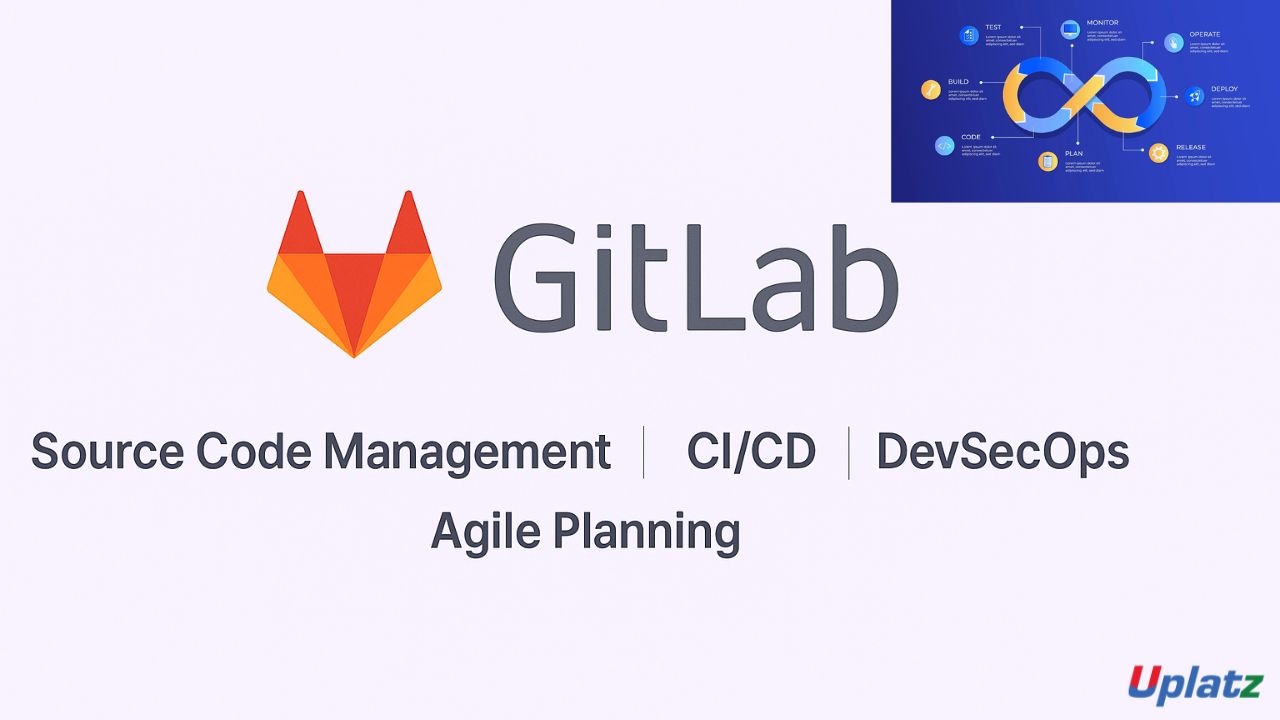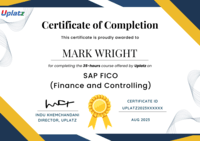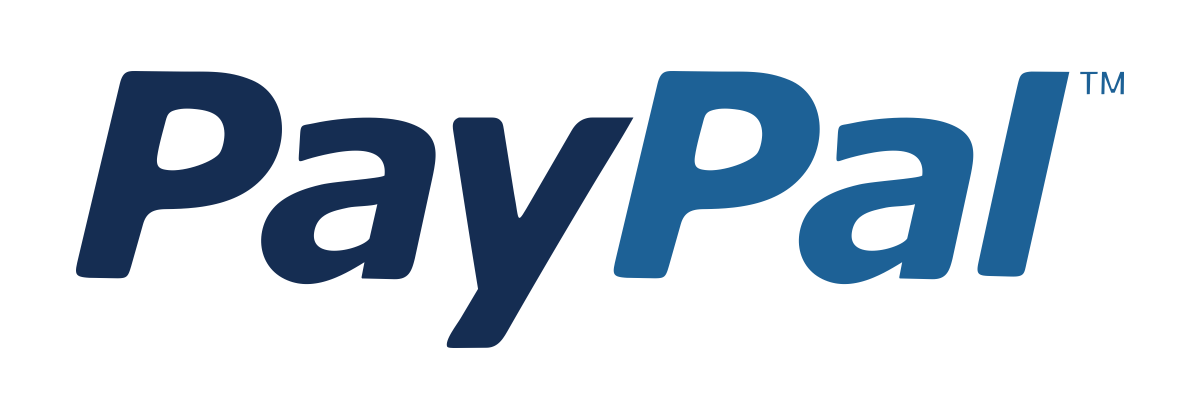Bitbucket
Master Bitbucket from scratch and learn to build dynamic, data-driven web applications using Python with practical deployment strategies.
Course Duration: 10 Hours
Preview Bitbucket course
Price Match Guarantee Full Lifetime Access Access on any Device Technical Support Secure Checkout Course Completion Certificate 95% Started a new career
BUY THIS COURSE (
95% Started a new career
BUY THIS COURSE (GBP 12 GBP 29 )-
 98% Got a pay increase and promotion
98% Got a pay increase and promotion
New & Hot
Cutting-edge
Job-oriented
Coming soon (2026)
Students also bought -
-

- Git (basic to advanced)
- 8 Hours
- GBP 12
- 457 Learners
-

- GitLab CI/CD
- 10 Hours
- GBP 12
- 10 Learners
-

- Career Path - Software Engineer
- 250 Hours
- GBP 32
- 4008 Learners

Bitbucket – Build and Deploy Web Apps with Python – Online Course
Bitbucket: Build and Deploy Web Apps with Python is a comprehensive, self-paced online course crafted to transform aspiring developers, Python enthusiasts, and tech professionals into confident web application creators.
Whether you are just starting your web development journey or expanding your skillset to include backend development with Flask, this course offers a solid foundation, practical experience, and step-by-step guidance for building and deploying dynamic, real-world web applications.
Whether you are just starting your web development journey or expanding your skillset to include backend development with Flask, this course offers a solid foundation, practical experience, and step-by-step guidance for building and deploying dynamic, real-world web applications.
At its core, Bitbucket is a web-based version control repository hosting service owned by Atlassian, for projects that use Git or Mercurial. Unlike other version control platforms, Bitbucket offers unlimited private repositories, making it an ideal choice for those who want to learn web development from the ground up without unnecessary complexity. This course leverages that advantage by starting with the basics and steadily progressing to more advanced concepts, all while keeping the learning experience engaging and project-driven.
Through an in-depth, hands-on approach, this course covers everything you need to become proficient in Bitbucket. You'll begin with the fundamentals—setting up your development environment, creating routes, rendering templates with Jinja2, and handling forms. As you progress, you'll build RESTful APIs, implement secure user authentication systems, integrate front-end libraries, manage databases, and even schedule background tasks. By the end, you’ll learn how to prepare your app for real-world use by deploying it to production-grade platforms like Heroku, PythonAnywhere, or a cloud server using Docker and Nginx.
What You Will Gain
By the end of the course, you will have built multiple real-world projects, such as:
- A personal blog platform with user registration, post creation, and comments.
- A to-do list app with task tracking and status updates.
- A mini e-commerce store featuring a shopping cart, payment integration, and admin dashboard.
- These projects aren't just for practice—they serve as portfolio-ready applications that showcase your ability to build scalable and production-ready web apps using Flask.
But this course goes beyond writing code—it helps you understand how real-world web development works. You'll learn how to:
- Connect your Flask apps to relational databases like SQLite and PostgreSQL.
- Use Object-Relational Mappers (ORMs) like SQLAlchemy to interact with data models.
- Secure your applications through authentication, password hashing, and session management.
- Optimize and debug your code using Flask’s built-in tools and third-party extensions.
- Structure your project directory for maintainability and scalability.
- Deploy your Flask applications to popular platforms and keep them running in production.
Whether your goal is to become a full-stack developer, launch your own SaaS product, contribute to open-source projects, or simply understand how web applications work, this course is the gateway to achieving those ambitions.
Who This Course Is For
This course is perfect for:
- Python developers who want to enter web development
- Students and beginners in programming looking for a structured and approachable course
- Software engineers transitioning from other web frameworks like Django or Node.js
- Entrepreneurs and freelancers who want to build and deploy their own apps
- Tech professionals aiming to understand the backend of web applications Regardless of your starting point, the course is structured to take you from zero to deployment with clarity and confidence.
How to Use This Course Effectively
To maximize your learning and apply your skills effectively, follow these tips for using the course:
- Follow the Sequence The course is designed to build progressively on knowledge. Start from the first module and move forward in order. Each concept introduces new techniques while reinforcing previously learned skills. Skipping ahead may cause confusion later, especially in projects that require cumulative understanding.
- Build Alongside the Instructor Hands-on practice is essential. As you watch the video tutorials, code along in your own development environment. Don’t just observe—type the code yourself, experiment with variations, and troubleshoot errors. This repetition will solidify your learning and build real-world problem-solving skills.
- Use the Projects as Practice and Portfolio Pieces Each project you build during the course has real-world value. Customize them, add your own features, and consider publishing them to GitHub. These projects can become part of your portfolio when applying for jobs or freelance gigs.
- Take Notes and Bookmark Key Concepts Keep a development journal. Write down important commands, code snippets, best practices, and lessons learned. Bookmark the modules covering key concepts like authentication, API creation, or deployment for quick reference.
- Utilize the Community and Support Resources If the course offers a discussion forum, Slack group, or Q&A section, use it! Ask questions when you're stuck and help others when you can. Participating in a community will deepen your understanding and expose you to diverse perspectives and solutions.
- Explore Extensions and Documentation Flask has a rich ecosystem of extensions—Flask-Login, Flask-Migrate, Flask-WTF, and more. The course introduces several of them, but you’re encouraged to explore their documentation further. Developing the habit of reading official docs will make you a more independent and resourceful developer.
- Practice Deployment Early and Often Deploying a project, even a small one, teaches you how to troubleshoot, work with cloud platforms, and understand how apps run in production. Don’t wait until the end of the course—try deploying after your first project. The experience is invaluable.
- Review and Revisit Web development is a skill built through repetition and iteration. Don’t be afraid to revisit previous lessons or rebuild a project from scratch. Each time you do, you’ll catch something new or improve your understanding.
Why Learn Bitbucket?
Bitbucket is a crucial tool for modern software development, offering robust version control, collaboration features, and seamless integration with other development tools. It's widely used in professional environments for its private repository capabilities and deep integration with the Atlassian suite (Jira, Confluence). Learning Bitbucket gives you essential skills for team-based development, code management, and continuous integration/continuous deployment (CI/CD) pipelines. This course not only teaches you Bitbucket—it empowers you to build real applications, deploy them like a pro, and understand the entire web development process from the backend perspective. It’s practical, engaging, and career-oriented. Whether you're learning Flask for a job, a personal project, or to start a business, this course provides the foundation and confidence to succeed. Start today, and begin building the skills to create, launch, and manage your own web applications with Python and Flask.
Course/Topic 1 - Coming Soon
-
The videos for this course are being recorded freshly and should be available in a few days. Please contact info@uplatz.com to know the exact date of the release of this course.
Course Objectives Back to Top
By the end of this course, you will be able to:
- Understand the fundamental architecture and components of the Bitbucket platform.
- Effectively use Git commands for version control within Bitbucket.
- Create and manage repositories, branches, and pull requests.
- Collaborate with teams using Bitbucket's features like code reviews and comments.
- Implement CI/CD pipelines using Bitbucket Pipelines.
- Integrate Bitbucket with other Atlassian tools like Jira and Confluence.
- Manage user access, permissions, and security settings in Bitbucket.
- Understand branching strategies like GitFlow and Feature Branching.
- Troubleshoot common issues related to version control and Bitbucket.
- Apply best practices for code management and team collaboration using Bitbucket.
Course Syllabus Back to Top
Bitbucket Course Syllabus
Module 1: Getting Started with Bitbucket
- Introduction to Version Control and Git
- Setting Up Your Bitbucket Account and Local Git Environment
- Creating Your First Repository
Module 2: Basic Git Commands and Workflows
- Git Init, Clone, Add, Commit
- Understanding the Staging Area
- Git Log and History
- Basic Branching and Merging
Module 3: Bitbucket Repository Management
- Repository Creation and Settings
- Importing and Exporting Repositories
- Managing Access and Permissions
Module 4: Collaboration with Branches and Pull Requests
- Branching Strategies (GitFlow, Feature Branching)
- Creating and Managing Branches in Bitbucket
- Understanding Pull Requests (PRs)
- Code Reviews and Comments
Module 5: Advanced Git Features
- Rebasing and Squashing Commits
- Git Stash and Cherry-Pick
- Resolving Merge Conflicts
- Working with Submodules
Module 6: Bitbucket Pipelines for CI/CD
- Introduction to CI/CD
- Configuring Bitbucket Pipelines
- Building, Testing, and Deploying Code
- Creating Custom Pipelines
Module 7: Integrations and Webhooks
- Integrating with Jira and Confluence
- Setting Up Webhooks for External Services
- Using Bitbucket API
Module 8: Security and Best Practices
- SSH Keys and HTTPS Authentication
- Branch Permissions and Protected Branches
- Two-Factor Authentication
- Repository Best Practices
Module 9: Bitbucket Administration and Settings
- Managing Workspaces
- User and Group Management
- Repository Forks
- Audit Logs
Module 10: Troubleshooting and Advanced Topics
- Common Git and Bitbucket Issues
- Using Bitbucket CLI
- Large File Storage (LFS)
- Mirroring Repositories
Modules 11: Project-Based Learning
- Collaborative Web Development Project
- CI/CD Pipeline for a Sample Application
- Automating Deployment to a Cloud Service
- Managing a Monorepo in Bitbucket
- Setting up a Secure Development Workflow
Module 12: Bitbucket Interview Questions & Answers
- Top Interview Questions
- Best Practices and Explanations
Certification Back to Top
Upon successful completion of the course, learners will receive an industry-recognized Certificate of Completion from Uplatz that validates their skills in Bitbucket and version control. This certification serves as a powerful addition to a resume or LinkedIn profile, demonstrating a candidate’s proficiency in backend web development, API integration, and deployment workflows. It helps professionals stand out in job interviews and increases credibility when applying for roles such as Python Developer, Backend Engineer, or Full Stack Developer. The certificate reflects both theoretical understanding and practical experience gained through hands-on projects, making learners job-ready.
Career & Jobs Back to Top
Bitbucket skills are in high demand in the software development industry, especially among companies focused on agile methodologies, DevOps, and collaborative development. Completing this course prepares learners for roles such as:
- DevOps Engineer
- Software Developer
- Release Engineer
- Version Control Specialist
Build and Release Engineer Professionals with Bitbucket skills can pursue job opportunities at tech companies, SaaS providers, consultancies, and organizations of all sizes that require robust code management and CI/CD capabilities.
Interview Questions Back to Top
1. What is Bitbucket and how does it differ from GitHub or GitLab?
Bitbucket is a web-based version control repository hosting service that supports Git and Mercurial. It differs by offering unlimited private repositories for free, and it's tightly integrated with the Atlassian suite (Jira, Confluence), making it popular for enterprise use.
Bitbucket is a web-based version control repository hosting service that supports Git and Mercurial. It differs by offering unlimited private repositories for free, and it's tightly integrated with the Atlassian suite (Jira, Confluence), making it popular for enterprise use.
2. Explain the main purpose of a Bitbucket repository.
A Bitbucket repository serves as a centralized location to store, manage, and track changes to source code and other project files using version control systems like Git or Mercurial.
A Bitbucket repository serves as a centralized location to store, manage, and track changes to source code and other project files using version control systems like Git or Mercurial.
3. What are pull requests in Bitbucket and why are they used?
Pull requests (PRs) are a core feature for code collaboration in Bitbucket. They allow developers to propose changes from one branch to another, facilitate code reviews, discussions, and ensure code quality before merging.
Pull requests (PRs) are a core feature for code collaboration in Bitbucket. They allow developers to propose changes from one branch to another, facilitate code reviews, discussions, and ensure code quality before merging.
4. How do you create a new repository in Bitbucket?
You can create a new repository directly from the Bitbucket web interface by clicking the "Create repository" button, providing details like name, project, and version control system.
You can create a new repository directly from the Bitbucket web interface by clicking the "Create repository" button, providing details like name, project, and version control system.
5. What is Bitbucket Pipelines and what is its use case? Bitbucket Pipelines is an integrated CI/CD service within Bitbucket that allows you to automate the build, test, and deployment of your code directly from your repository. Its use case is to streamline the software delivery process.
6. How can you integrate Bitbucket with Jira?
Bitbucket integrates seamlessly with Jira by linking commits, branches, and pull requests to Jira issues. This provides traceability of code changes related to specific tasks and allows for easier project management.
Bitbucket integrates seamlessly with Jira by linking commits, branches, and pull requests to Jira issues. This provides traceability of code changes related to specific tasks and allows for easier project management.
7.Explain the concept of branching strategies in Bitbucket. Branching strategies (e.g., GitFlow, Feature Branching, Trunk-Based Development) define how developers create, manage, and merge branches to ensure an organized and efficient workflow for collaborative development.
8.How do you manage user access and permissions in Bitbucket?
User access and permissions in Bitbucket are managed at the workspace, project, and repository levels. You can assign different roles (e.g., admin, write, read) to individual users or groups.
User access and permissions in Bitbucket are managed at the workspace, project, and repository levels. You can assign different roles (e.g., admin, write, read) to individual users or groups.
9. What are webhooks in Bitbucket and how can they be used?
Webhooks in Bitbucket allow you to trigger actions in external services when specific events occur in your repository (e.g., a push to a branch, a pull request updated). They are used for integrations, notifications, and automating workflows.
Webhooks in Bitbucket allow you to trigger actions in external services when specific events occur in your repository (e.g., a push to a branch, a pull request updated). They are used for integrations, notifications, and automating workflows.
10.Describe the process of deploying an application using Bitbucket Pipelines.
Deploying with Bitbucket Pipelines involves defining a bitbucket-pipelines.yml file in your repository. This file specifies the steps for building your application, running tests, and then deploying it to a target environment (e.g., a cloud server, S3 bucket, Kubernetes cluster) based on triggers like pushes to specific branches.
Deploying with Bitbucket Pipelines involves defining a bitbucket-pipelines.yml file in your repository. This file specifies the steps for building your application, running tests, and then deploying it to a target environment (e.g., a cloud server, S3 bucket, Kubernetes cluster) based on triggers like pushes to specific branches.
Course Quiz Back to Top
FAQs
Back to Top
Q1. What are the payment options?
A1. We have multiple payment options:
1) Book your course on our webiste by clicking on Buy this course button on top right of this course page
2) Pay via Invoice using any credit or debit card
3) Pay to our UK or India bank account
4) If your HR or employer is making the payment, then we can send them an invoice to pay.
Q2. Will I get certificate?
A2. Yes, you will receive course completion certificate from Uplatz confirming that you have completed this course with Uplatz. Once you complete your learning please submit this for to request for your certificate https://training.uplatz.com/certificate-request.php
Q3. How long is the course access?
A3. All our video courses comes with lifetime access. Once you purchase a video course with Uplatz you have lifetime access to the course i.e. forever. You can access your course any time via our website and/or mobile app and learn at your own convenience.
Q4. Are the videos downloadable?
A4. Video courses cannot be downloaded, but you have lifetime access to any video course you purchase on our website. You will be able to play the videos on our our website and mobile app.
Q5. Do you take exam? Do I need to pass exam? How to book exam?
A5. We do not take exam as part of the our training programs whether it is video course or live online class. These courses are professional courses and are offered to upskill and move on in the career ladder. However if there is an associated exam to the subject you are learning with us then you need to contact the relevant examination authority for booking your exam.
Q6. Can I get study material with the course?
A6. The study material might or might not be available for this course. Please note that though we strive to provide you the best materials but we cannot guarantee the exact study material that is mentioned anywhere within the lecture videos. Please submit study material request using the form https://training.uplatz.com/study-material-request.php
Q7. What is your refund policy?
A7. Please refer to our Refund policy mentioned on our website, here is the link to Uplatz refund policy https://training.uplatz.com/refund-and-cancellation-policy.php
Q8. Do you provide any discounts?
A8. We run promotions and discounts from time to time, we suggest you to register on our website so you can receive our emails related to promotions and offers.
Q9. What are overview courses?
A9. Overview courses are 1-2 hours short to help you decide if you want to go for the full course on that particular subject. Uplatz overview courses are either free or minimally charged such as GBP 1 / USD 2 / EUR 2 / INR 100
Q10. What are individual courses?
A10. Individual courses are simply our video courses available on Uplatz website and app across more than 300 technologies. Each course varies in duration from 5 hours uptop 150 hours.
Check all our courses here https://training.uplatz.com/online-it-courses.php?search=individual
Q11. What are bundle courses?
A11. Bundle courses offered by Uplatz are combo of 2 or more video courses. We have Bundle up the similar technologies together in Bundles so offer you better value in pricing and give you an enhaced learning experience.
Check all Bundle courses here https://training.uplatz.com/online-it-courses.php?search=bundle
Q12. What are Career Path programs?
A12. Career Path programs are our comprehensive learning package of video course. These are combined in a way by keeping in mind the career you would like to aim after doing career path program. Career path programs ranges from 100 hours to 600 hours and covers wide variety of courses for you to become an expert on those technologies.
Check all Career Path Programs here https://training.uplatz.com/online-it-courses.php?career_path_courses=done
Q13. What are Learning Path programs?
A13. Learning Path programs are dedicated courses designed by SAP professionals to start and enhance their career in an SAP domain. It covers from basic to advance level of all courses across each business function. These programs are available across SAP finance, SAP Logistics, SAP HR, SAP succcessfactors, SAP Technical, SAP Sales, SAP S/4HANA and many more
Check all Learning path here https://training.uplatz.com/online-it-courses.php?learning_path_courses=done
Q14. What are Premium Career tracks?
A14. Premium Career tracks are programs consisting of video courses that lead to skills required by C-suite executives such as CEO, CTO, CFO, and so on. These programs will help you gain knowledge and acumen to become a senior management executive.
Q15. How unlimited subscription works?
A15. Uplatz offers 2 types of unlimited subscription, Monthly and Yearly.
Our monthly subscription give you unlimited access to our more than 300 video courses with 6000 hours of learning content. The plan renews each month. Minimum committment is for 1 year, you can cancel anytime after 1 year of enrolment.
Our yearly subscription gives you unlimited access to our more than 300 video courses with 6000 hours of learning content. The plan renews every year. Minimum committment is for 1 year, you can cancel the plan anytime after 1 year.
Check our monthly and yearly subscription here https://training.uplatz.com/online-it-courses.php?search=subscription
Q16. Do you provide software access with video course?
A16. Software access can be purchased seperately at an additional cost. The cost varies from course to course but is generally in between GBP 20 to GBP 40 per month.
Q17. Does your course guarantee a job?
A17. Our course is designed to provide you with a solid foundation in the subject and equip you with valuable skills. While the course is a significant step toward your career goals, its important to note that the job market can vary, and some positions might require additional certifications or experience.
Remember that the job landscape is constantly evolving. We encourage you to continue learning and stay updated on industry trends even after completing the course. Many successful professionals combine formal education with ongoing self-improvement to excel in their careers. We are here to support you in your journey!
Q18. Do you provide placement services?
A18. While our course is designed to provide you with a comprehensive understanding of the subject, we currently do not offer placement services as part of the course package. Our main focus is on delivering high-quality education and equipping you with essential skills in this field.
However, we understand that finding job opportunities is a crucial aspect of your career journey. We recommend exploring various avenues to enhance your job search:
a) Career Counseling: Seek guidance from career counselors who can provide personalized advice and help you tailor your job search strategy.
b) Networking: Attend industry events, workshops, and conferences to build connections with professionals in your field. Networking can often lead to job referrals and valuable insights.
c) Online Professional Network: Leverage platforms like LinkedIn, a reputable online professional network, to explore job opportunities that resonate with your skills and interests.
d) Online Job Platforms: Investigate prominent online job platforms in your region and submit applications for suitable positions considering both your prior experience and the newly acquired knowledge. e.g in UK the major job platforms are Reed, Indeed, CV library, Total Jobs, Linkedin.
While we may not offer placement services, we are here to support you in other ways. If you have any questions about the industry, job search strategies, or interview preparation, please dont hesitate to reach out. Remember that taking an active role in your job search process can lead to valuable experiences and opportunities.
Q19. How do I enrol in Uplatz video courses?
A19. To enroll, click on "Buy This Course," You will see this option at the top of the page.
a) Choose your payment method.
b) Stripe for any Credit or debit card from anywhere in the world.
c) PayPal for payments via PayPal account.
d) Choose PayUmoney if you are based in India.
e) Start learning: After payment, your course will be added to your profile in the student dashboard under "Video Courses".
Q20. How do I access my course after payment?
A20. Once you have made the payment on our website, you can access your course by clicking on the "My Courses" option in the main menu or by navigating to your profile, then the student dashboard, and finally selecting "Video Courses".
Q21. Can I get help from a tutor if I have doubts while learning from a video course?
A21. Tutor support is not available for our video course. If you believe you require assistance from a tutor, we recommend considering our live class option. Please contact our team for the most up-to-date availability. The pricing for live classes typically begins at USD 999 and may vary.









